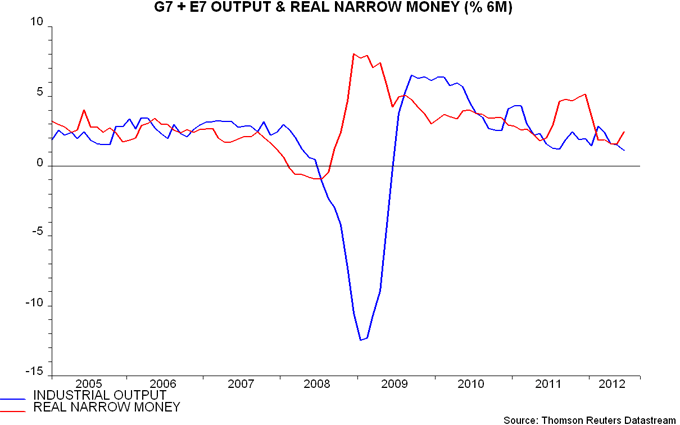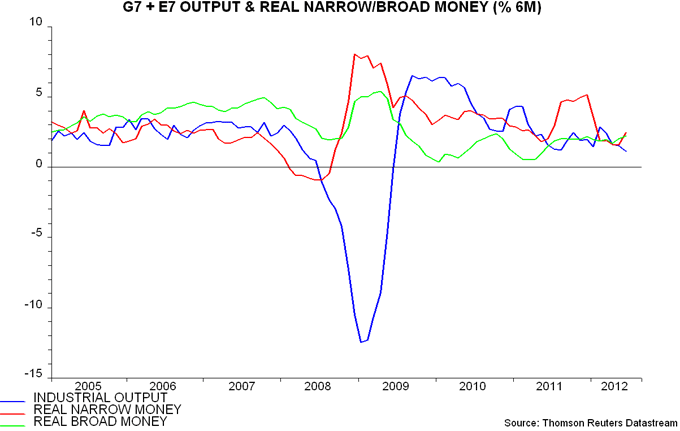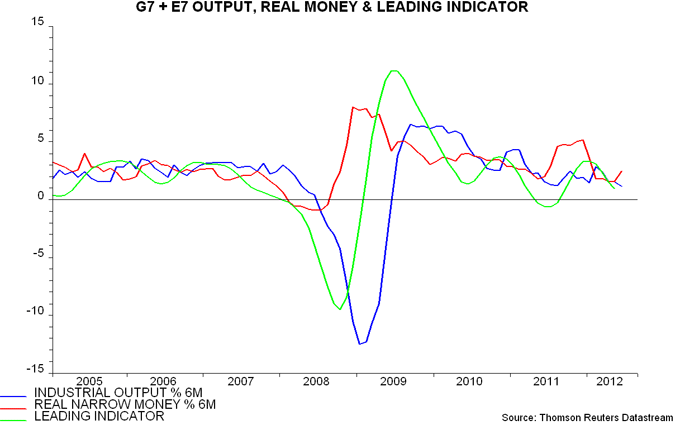Entries from July 29, 2012 - August 4, 2012
Eurozone monetary conditions improving at margin
Markets were unimpressed by the ECB President’s plan to intervene in sovereign bond markets but the initiative adds to a series of steps* taken by Sig. Draghi since assuming leadership of the central bank, the cumulative effect of which has been to reverse the monetary tightening that occurred under his predecessor, thereby improving prospects for the Eurozone economy.
There are two glimmers of hope in recent data. First, the six-month rate of change of Eurozone real narrow money M1 (i.e. deflated by consumer prices, seasonally adjusted, not annualised) rose further to 1.1% in June, the highest since September 2010 – see first chart. A contraction of real M1 in late 2010 / early 2011 and again last winter signalled the current recession. The recent recovery – predating the July cut in the refinancing and deposit rates – suggests that Eurozone-wide output will stabilise in late 2012.
Secondly, ECB lending to banks (i.e. either in refinancing operations or through the “back door” of national "emergency liquidity assistance" operations) has fallen slightly since mid-year following a surge in June – second chart. This could indicate a slowdown in deposit outflows from peripheral banks into the core, in turn suggesting a stabilisation of central bank imbalances within the TARGET2 clearing system.
The country breakdown of the monetary statistics shows a large contraction of real M1 deposits in the periphery in the six months to June, in contrast to a rise in the core, implying worse economic prospects – third chart. The gap, however, has narrowed and peripheral real deposits have risen in three of the last four months – fourth chart.
The news, in other words, is improving at the margin and President Draghi’s latest initiative should sustain the trend. Markets may be underestimating the differences between the new plan and the ineffectual securities markets programme – intervention will be “of a size adequate to meet its objective” rather than “temporary and limited”, the ECB will not assert credit seniority and bond-buying may be allowed to expand the monetary base. The key risk is that the German government will torpedo the plan by backing the Bundesbank’s opposition – but Sig. Draghi is unlikely to have launched his initiative without securing the implicit support of Chancellor Merkel.
*These steps include three quarter-point cuts in the key refinancing rate, a reduction to zero in the deposit rate paid on “excess” bank reserves, the injection of €1.0 trillion of subsidised medium-term funding – equivalent to 11% of Eurozone annual GDP – in the three-year LTROs conducted in December and February, and a loosening of the ECB’s collateral regime.




UK monetary pick-up at odds with consensus gloom
UK real money trends continued to improve in June, suggesting stronger economic performance in late 2012 / early 2013 – barring a major external shock.
The first chart shows six-month changes in seven real monetary aggregates (i.e. deflated by consumer prices, seasonally adjusted, not annualised). The changes are now positive for six of the seven measures, the exception being real M4, which continues to be depressed by a contraction of money holdings of economically-irrelevant “intermediate other financial corporations” (IOFCs). The generalised improvement partly reflects a slowdown in inflation but, in addition, nominal growth has risen in five of the six cases.
The second chart compares the two-quarter change in non-oil GDP with six-month changes in real broad and narrow money excluding volatile financial sector holdings (not just those of IOFCs). These measures contracted for much of 2011, thereby warning of recent economic weakness, allowing for the usual lag of about six months. June growth rates were the strongest since April and December 2009 respectively. This suggests that economic performance in late 2012 / 2013 will resemble that between mid-2009 and mid-2010, when non-oil GDP rose by an average 0.6% per quarter, or 2.3% annualised.
The monetary pick-up questions the necessity of the Bank’s additional stimulus measures since mid-year – these should further enhance economic prospects for 2013 but at the probable cost of creating “excess” liquidity that will distort asset prices and keep inflation elevated over the medium term.


Global real money uptick confirmed
Global six-month real narrow money expansion – the key economic forecasting indicator employed here – picked up in June after stabilising in April / May. Allowing for the usual half-year lead, this suggests that the six-month change in global industrial output will bottom in October / November and strengthen into year-end.
The global six-month real money growth measure – incorporating data for the G7 and seven large emerging economies – plunged from a peak of 5.2% (not annualised) in December 2011 to 1.8% in February, signalling a major economic slowdown in summer 2012. Six-month industrial output expansion is provisionally estimated to have reached a three-year low of 1.1% in June, with weak manufacturing PMI results for July indicating a further slide – see first chart.
Real money growth, however, edged only slightly lower after February, bottoming at 1.6% in April / May before rebounding to an estimated 2.5% in June (Korea and Russia have yet to release data). The suggestion, therefore, is that economic deterioration will be mostly over by August (i.e. six months from February), although news is unlikely to improve significantly until late 2012.
Narrow money is preferred here because of its superior forecasting performance but real broad money expansion has also firmed recently and stands at a respectable historical level – second chart.
The recent rally in equities may partly reflect anticipation of better economic conditions in 2013. Markets, however, may be underestimating the extent of near-term weakness and / or the pain threshold of central banks expected to deliver major further policy stimulus. The view here will remain cautious pending another month of improved monetary data and signs of stabilisation in the shorter-term leading indicator shown in the third chart – a June reading of this indicator will be available next week.




